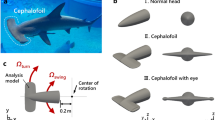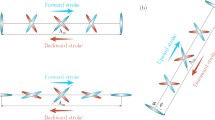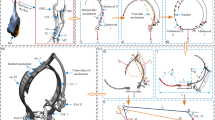Abstract
This paper presents biologically inspired control strategies for an autonomous underwater vehicle (AUV) propelled by flapping fins that resemble the paddle-like forelimbs of a sea turtle. Our proposed framework exploits limit cycle oscillators and diffusive couplings, thereby constructing coupled nonlinear oscillators, similar to the central pattern generators (CPGs) in animal spinal cords. This paper first presents rigorous stability analyses and experimental results of CPG-based control methods with and without actuator feedback to the CPG. In these methods, the CPG module generates synchronized oscillation patterns, which are sent to position-servoed flapping fin actuators as a reference input. In order to overcome the limitation of the open-loop CPG that the synchronization is occurring only between the reference signals, this paper introduces a new single-layered CPG method, where the CPG and the physical layers are combined as a single layer, to ensure the synchronization of the physical actuators in the presence of external disturbances. The key idea is to replace nonlinear oscillators in the conventional CPG models with physical actuators that oscillate due to nonlinear state feedback of the actuator states. Using contraction theory, a relatively new nonlinear stability tool, we show that coupled nonlinear oscillators globally synchronize to a specific pattern that can be stereotyped by an outer-loop controller. Results of experimentation with a turtle-like AUV show the feasibility of the proposed control laws.
Similar content being viewed by others
References
Arena, P., Fortuna, L., & Frasca, M. (2002). Multi-template approach to realize central pattern generators for artificial locomotion control. International Journal of Circuit Theory and Applications, 30(4), 441–458.
Bandyopadhyay, P., Singh, S., Thivierge, D., Annaswamy, A., Leinhos, H., Fredette, A., & Beal, D. (2008). Synchronization of animal-inspired multiple high-lift fins in an underwater vehicle using olivo–cerebellar dynamics. IEEE Journal of Oceanic, Engineering, 33(4), 563–578.
Beal, D. N., & Bandyopadhyay, P. R. (2007). A harmonic model of hydrodynamic forces produced by a flapping fin. Experiments in Fluids, 43(5), 675–682.
Buchli, J., Righetti, L., & Ijspeert, A. J. (2006). Engineering entrainment and adaptation in limit cycle systems. Biological Cybernetics, 95, 645–664.
Chen, Z., & Iwasaki, T. (2008). Circulant synthesis of central pattern generators with application to control of rectifier systems. IEEE Transactions on Automatic Control, 53(1), 273–286.
Chung, S.-J., & Slotine, J.-J. E. (2009). Cooperative robot control and concurrent synchronization of Lagrangian systems. IEEE Transactions on Robotics, 25(3), 686–700.
Collins, J. J., & Stewart, I. N. (1993). Coupled nonlinear oscillators and the symmetry of animal gaits. Journal of Nonlinear Science, 3, 349–392.
Crespi, A., & Ijspeert, A. (2006). Amphibot II: an amphibious snake robot that crawls and swims using a central pattern generator. In Proceedings of the 9th international conference on climbing and walking robots (CLAWAR 2006) (pp. 19–27). Brussels, Belgium.
Ekeberg, Ö. (1993). A combined neuronal and mechanical model of fish swimming. Biological Cybernetics, 69, 363–374.
Grillner, S., Deliagina, T., Ekeberg, Ö., El Manira, A., Hill, R., Lansner, A., Orlovski, G., & Wallen, P. (1995). Neural networks that co-ordinate locomotion and body orientation in the lamprey. Trends in Neurosciences, 18, 270–279.
Grillner, S., Ekeberg, Ö., El Manira, A., Lansner, A., Parker, D., Tegnér, J., & Wallén, P. (1998). Intrinsic function of a neuronal network—a vertebrate central pattern generator. Brain Research Reviews, 26, 184–197.
Hirose, S. (1993). Biologically inspired robots: snake-like locomotors and manipulators. Oxford: Oxford University Press.
Ijspeert, A., Crespi, A., Ryczko, D., & Cabelguen, J.-M. (2007). From swimming to walking with a salamander robot driven by a spinal cord model. Science, 315(5817), 1416–1420.
Iwasaki, T., & Zheng, M. (2006). Sensory feedback mechanism underlying entertainment of central pattern generator to mechanical resonance. Biological Cybernetics, 94(4), 245–261.
Khalil, H. K. (2002). Nonlinear Systems (3rd edn.). New York: Prentice-Hall.
Krouchev, N., Kalaska, J. F., & Drew, T. (2006). Sequential activation of muscle synergies during locomotion in the intact cat as revealed by cluster analysis and direct decomposition. Journal of Neurophysiology, 96, 1991–2010.
Lewis, M. A., Tenore, F., & Etienne-Cummings, R. (2005). CPG design using inhibitory networks. In Proceedings of the 2005 IEEE international conference on robotics and automation (pp. 3682–3687). Barcelona, Spain.
Licht, S., Polidoro, V., Flores, M., Hover, F., & Triantafyllou, M. (2004). Design and projected performance of a flapping foil AUV. IEEE Journal of Oceanic Engineering, 29(3), 786–794.
Morimoto, J., Endo, G., Nakanishi, J., Hyon, S.-H., Cheng, G., Bentivegna, D., & Atkeson, C. G. (2006). Modulation of simple sinusoidal patterns by a coupled oscillator model for biped walking. In Proceedings of the 2006 IEEE international conference on robotics and automation (pp. 1579–1584).
Olfati-Saber, R., & Murray, R. M. (2004). Consensus problems in networks of agents with switching topology and time-delays. IEEE Transactions on Automatic Control, 49(9), 1520–1533.
Pham, Q.-C., & Slotine, J.-J. E. (2007). Stable concurrent synchronization in dynamic system networks. Neural Networks, 20(1), 62–77.
Pikovsky, A., Rosenblum, M., & Kurths, J. (2001). Synchronization: a universal concept in nonlinear sciences. Cambridge: Cambridge University Press.
Rybak, I. A., Shevtsova, N. A., Lafreniere-Roula, M., & McCrea, D. A. (2006). Modelling spinal circuitry involved in locomotor pattern generation: insights from deletions during fictive locomotion. Journal of Physiology, 577(2), 617–639.
Seo, K., Chung, S.-J., & Slotine, J.-J. (2008). CPG-based control of a turtle-like underwater vehicle. In Proceedings of robotics: science and systems IV. Zurich, Switzerland.
Seo, K., & Slotine, J.-J. E. (2007). Models for global synchronization in CPG-based locomotion. In Proceedings of 2007 IEEE international conference on robotics and automation (pp. 281–286). Rome, Italy.
Stent, G. S., Kristan, W. B. Jr., Friesen, W. O., Ort, C. A., Poon, M., & Calabrese, R. L. (1978). Neuronal generation of the leech swimming movement. Science, New Series, 200(4348), 1348–1357.
Strogatz, S. (2000). From Kuramoto to Crawford: exploring the onset of synchronization in populations of coupled oscillators. Physica D, 143, 1–20.
Strogatz, S. (2001). Nonlinear dynamics and chaos: with applications to physics, biology, chemistry, and engineering (studies in nonlinearity). Cambridge: Perseus Books Group.
Taga, G. (1998). A model of the neuro-musculo-skeletal system for anticipatory adjustment of human locomotion during obstacle avoidance. Biological Cybernetics, 78(1), 9–17.
Taga, G., Yamaguchi, Y., & Shimizu, H. (1991). Self-organized control of bipedal locomotion by neural oscillators in unpredictable environment. Biological Cybernetics, 65(3), 147–159.
Triantafyllou, M., & Triantafyllou, G. (1995). An efficient swimming machine. Scientific American, 272(3), 64–70.
Tuwankotta, J. M. (2000). Studies on Rayleigh equation. INTEGRAL, 5(1).
Vogelstein, R. J., Tenore, F., Etienne-Cummings, R., Lewis, M. A., & Cohen, A. H. (2006). Dynamic control of the central pattern generator for locomotion. Biological Cybernetics, 95(6), 555–566.
Wang, W., & Slotine, J.-J. E. (2005). On partial contraction analysis for coupled nonlinear oscillators. Biological Cybernetics, 92(1), 38–53.
Wang, M., & Yu, J. (2008). Intelligent robotics and applications, Part I. In LNAI : Vol. 5314. Parameter design for a central pattern generator based locomotion controller (pp. 352–361). Berlin: Springer.
Author information
Authors and Affiliations
Corresponding author
Electronic Supplementary Material
Below is the link to the electronic supplementary material. (WMV 15.1 MB)
Below is the link to the electronic supplementary material. (WMV 7.37 MB)
Rights and permissions
About this article
Cite this article
Seo, K., Chung, SJ. & Slotine, JJ.E. CPG-based control of a turtle-like underwater vehicle. Auton Robot 28, 247–269 (2010). https://doi.org/10.1007/s10514-009-9169-0
Received:
Accepted:
Published:
Issue Date:
DOI: https://doi.org/10.1007/s10514-009-9169-0




